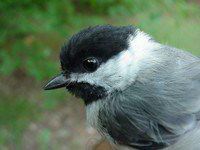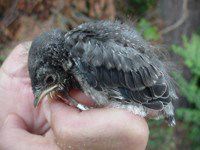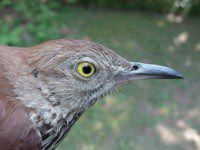|
|
|||
|
THIS WEEK at HILTON POND |
|
It's A Boy! It's A Girl! While walking the trails at Hilton Pond Center last October, we encountered a well-fed female Carolina Mantid (below right) that likely had been striking fear into the open circulatory systems of smaller insects and spiders. Despite her hunting ability, we knew the mantid would soon meet her own demise when cool weather came, so we looked long and hard for an egg case to show she at least had made accommodations for passing on her genes to a new generation. Unlike the large, spherical, and more-visible egg case laid by introduced Chinese mantids, that of the native Carolina Mantis is often hard to find. In February, well after autumn leaf-fall and before spring green-up, we finally came across the two-tone brown egg case we'd been seeking. It was on the outer branch of a Sweetgum tree (Liquidambar styraciflua), situated such that it looked almost like a fat part of the twig (below left). Over the past ten weeks or so, several visitors have asked what the object was, and each time we told them it was an apparently viable egg case of a Carolina Mantid that would probably hatch out in late spring and produce dozens of baby mantids. Never, however, did we expend the few minutes of effort it would take to find a jar and place the egg case in it. All this became moot at 10:13 a.m. on 31 May 2001 when we returned from checking mist nets to find--you guessed it--the egg case was spewing forth its contents (below) and reminding us of just how slack we had been in not avoiding this inevitable scenario. Fortunately, we arrived just in time for midwife duties; all the babes were either unhatched or they were merely exploring the piece of printer paper on which the twig had been sitting on this particular day. 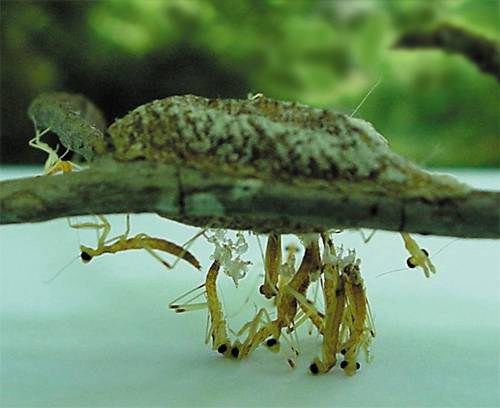 We immediately transported the whole maternity ward to a railing on the back porch and tried taking digital photos of the newborns--no easy task because they began scampering away on their six spindly legs that just a few minutes earlier had been soft and twisted inside each individual egg. After each youngster hatched, it dangled from the egg case by a thin thread until its exoskeleton hardened. The whole process--from emergence to being able to walk--only took a few minutes, and it's miraculous that all the 50 or so mantids that hatched appeared to be perfectly formed and fully functional.
It's always interesting to watch nature being reborn, but in the case of this particular litter of Carolina Mantids, we feel more like proud grandparents than dispassionate observers. Care to see some pictures of our grandchildren?  If you enjoy "This Week at Hilton Pond," please help Support Hilton Pond Center for Piedmont Natural History |

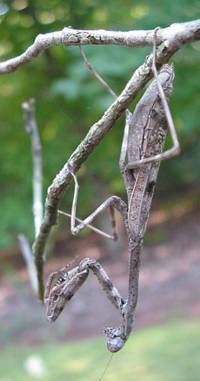 This three-inch-long Praying Mantis species (Stagmomantis carolina)--which happens to be the Official Insect of the equally feisty little State of South Carolina--preys on just about any terrestrial arthropod it can catch.
This three-inch-long Praying Mantis species (Stagmomantis carolina)--which happens to be the Official Insect of the equally feisty little State of South Carolina--preys on just about any terrestrial arthropod it can catch. We snipped off a 12" length that included the egg case and brought it back to the lab at Hilton Pond Center--fully intending to put it in a large jar because we knew absolutely what would happen if we didn't. One thing led to another, of course, and the twig sat on our desk day after day, sometimes poised atop the printer or leaning against the window, and even being used as a temporary bookmark when our hands were full of banded birds.
We snipped off a 12" length that included the egg case and brought it back to the lab at Hilton Pond Center--fully intending to put it in a large jar because we knew absolutely what would happen if we didn't. One thing led to another, of course, and the twig sat on our desk day after day, sometimes poised atop the printer or leaning against the window, and even being used as a temporary bookmark when our hands were full of banded birds.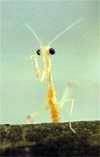 As we moved the camera in close for macrophotography, each mantid struck a defensive posture (left), tried to stare us down with its beady little compound eyes, and then attacked the lens--apparently not realizing we outweighed the hatchling about a zillion to one. Very few of the baby mantids would stand still for a mug shot, choosing instead to scurry along the porch railing toward shrubs at one end; some lost their grips and floated almost weightlessly to the ground below. Had a hungry chickadee or warbler been around at this moment, we're certain almost none of the hatchlings would have gone uneaten, but for the moment they all had a head start on life.
As we moved the camera in close for macrophotography, each mantid struck a defensive posture (left), tried to stare us down with its beady little compound eyes, and then attacked the lens--apparently not realizing we outweighed the hatchling about a zillion to one. Very few of the baby mantids would stand still for a mug shot, choosing instead to scurry along the porch railing toward shrubs at one end; some lost their grips and floated almost weightlessly to the ground below. Had a hungry chickadee or warbler been around at this moment, we're certain almost none of the hatchlings would have gone uneaten, but for the moment they all had a head start on life.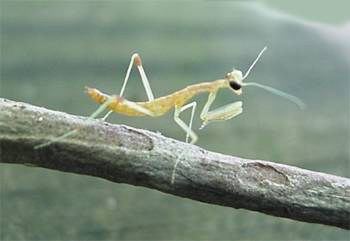 Except for their translucent tan coloration, young mantids look much like adults--the front legs modified into "praying" position are distinctive--but a very close look will reveal they lack wings (right). Each hatchling will undergo at least a half-dozen molts between now and when it becomes sexually mature at summer's end, and not until the final one will it have fully functional wings. In the meantime, it will consume a lot of insects, starting off--we suppose--with fruit flies and gnats and ending up with bumblebees and beetles.
Except for their translucent tan coloration, young mantids look much like adults--the front legs modified into "praying" position are distinctive--but a very close look will reveal they lack wings (right). Each hatchling will undergo at least a half-dozen molts between now and when it becomes sexually mature at summer's end, and not until the final one will it have fully functional wings. In the meantime, it will consume a lot of insects, starting off--we suppose--with fruit flies and gnats and ending up with bumblebees and beetles.
